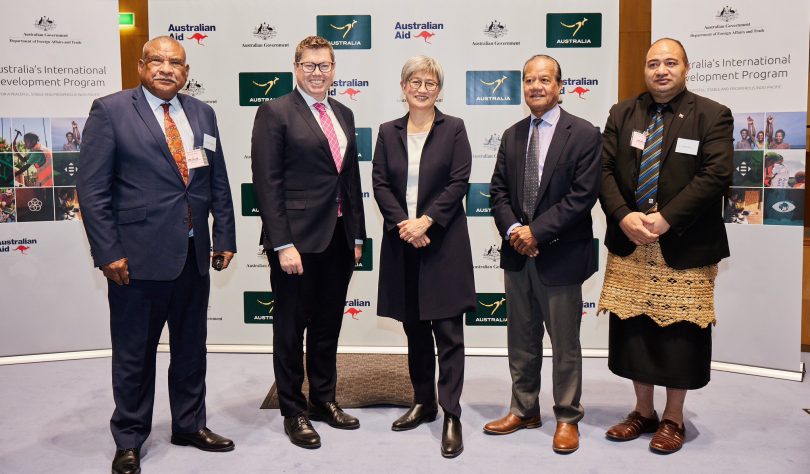Cameron Hill described Australia’s new development policy as Labor’s turn to statecraft on this blog – referencing the policy’s explicit identification of development as “one of our tools of statecraft”. In addition, he cited remarks at the launch from Foreign Minister Penny Wong on the need “to deploy all of our national power – all tools of statecraft”, and from Minister for International Development and the Pacific Pat Conroy who described development as “a vital tool for advancing a peaceful, stable and prosperous region”.
Hill’s identification of a “turn to statecraft” is spot on, and the new development policy is the latest in a series of key policy documents that use such framing. The Defence Strategic Review, released in March, focuses on a “whole-of-government statecraft effort”, for example, and a federal budget media release in May commits to “invest in all elements of our statecraft including diplomatic power, trade and development”. Should DFAT publicly release its diplomatic capability review, my bet would be on it using similar language.
That would be consistent with the government’s messaging since coming to office, with Minister Wong’s and Minister Conroy’s remarks just the latest in a series of speeches by ministers and senior officials – including the Prime Minister, the Deputy Prime Minister and Chief of the Defence Force – outlining the importance of a whole-of-government, whole-of-nation approach to foreign policy. This isn’t just a Labor assessment either – there’s support from all major parties.
There are several ways the term “statecraft” is employed. But at a base level, it describes the full suite of levers that a nation-state can pull to influence the policies, behaviours and attitudes of other actors, thereby shaping its own external environment. Australian government rhetoric would suggest it shares this comprehensive definition.
With this “tool of statecraft” approach becoming institutionalised, what should the development sector read into it?
First and foremost, it shows development is being respected as an integral element of Australia’s international engagement (though questions on resourcing and implementation remain). Rather than subordinating development to defence or diplomacy agendas, a genuine all tools of statecraft approach gives development a seat at the table where decisions are made on the direction and objectives of Australia’s international engagement overall. In this respect, the new policy will, in the words of Australian Council for International Development (ACFID) Chief Executive Officer Marc Purcell, “go a long way towards restoring development to the heart of foreign policy … and will help re-establish development as a vital lever in the quest for global influence”.
Those in the sector may find reference to “influence” jarring – some wryly observe that “the ‘I’ word” has become one “not to be spoken in polite development company”. The policy’s statement that “security and development are indivisible”, and the clear tying of development to “Canberra’s broader foreign policy and strategic intent”, may also elicit consternation.
To be clear, concerns over the instrumentalisation of aid should be taken seriously, particularly given the risks of short-term transactionalism and noting that Minister Conroy himself has said that Australian aid shouldn’t be transactional in the foreword of the policy. But while strategic influence shouldn’t be the justification for development spend, geopolitical competition isn’t something that can be pretended away. Moreover, if a particular outcome is strategically beneficial, that doesn’t automatically mean it isn’t developmentally positive. A nuanced approach would see “Australia’s development agenda best advanced in parallel to its geopolitical agenda”, recognising that “development cooperation is morally right and strategically smart” when “deployed effectively and with integrity”. The new policy makes it clear that the key objective of “an Indo-Pacific that is peaceful, stable, and prosperous” is of mutual interest to both the region and to Australia.
Involving the development sector in conversations on Australian statecraft at the strategic level reduces the likelihood it will be co-opted tactically later on. As Minister Conroy said at the 2022 ACFID conference, it also gives “great[er] ownership across all government and aid policies, which means that we can get more resources for it”. Influence works both ways, and there are many lessons that the development community can impart to Australia’s other tools of statecraft. Minister Conroy’s position is that “[development] shouldn’t be an appendix to our deliberations with how we engage with the rest of the world, it should be at the heart of what we do”. When each tool of statecraft is respected, resourced and coordinated, Minister Wong says the whole is greater than the sum of its parts.
Cameron Hill’s piece warns that if the development program doesn’t address regional needs – be it through under-resourcing or transactionalism – then it will undercut Australian statecraft. The flipside of this is that a genuine all tools of statecraft approach will have development objectives firmly embedded from the outset. As with the policy, questions remain over exactly what such an approach will look like in practice, and how it will be implemented. But by using such a framing, the new policy takes a step in the right direction of restoring development to the heart of Australian foreign policy.
All blogs on the 2023 Australian international development policy can be found here.
Disclosure
AP4D is hosted by the Australian Council for International Development and receives funding from the Australian Civil-Military Centre and the Department of Foreign Affairs and Trade. The views represent those of the author only.


Leave a Comment